Machine Learning Techniques for Fine Dead Fuel Load Estimation Using Multi-Source Remote Sensing Data
Abstract
1. Introduction
2. Materials and Methods
2.1. Study Area
2.2. Field Data
2.3. Remote Sensing Data
2.3.1. Sentinel-1 Data
2.3.2. Sentinel-2 Data
2.3.3. LIDAR Data
2.4. Geomorphological and Land-Cover Data
2.5. Pre-Processing and Feature Selection
2.6. Machine Learning Models
2.7. Model Performances and Assessment of Variable Importance
3. Results
3.1. Preliminary Results
3.2. Fine Dead Fuel Load Estimation and Model Selection
3.3. Variable Importance
3.4. Fine Dead Fuel Map
4. Discussion
5. Conclusions
Supplementary Materials
Author Contributions
Funding
Institutional Review Board Statement
Informed Consent Statement
Acknowledgments
Conflicts of Interest
Declaration of Competing Interest
References
- Moreira, F.; Viedma, O.; Arianoutsou, M.; Curt, T.; Koutsias, N.; Rigolot, E.; Barbati, A.; Corona, P.; Vaz, P.; Xanthopoulos, G.; et al. Landscape—Wildfire Interactions in Southern Europe: Implications for Landscape Management. J. Environ. Manag. 2011, 92, 2389–2402. [Google Scholar] [CrossRef]
- Ganteaume, A.; Camia, A.; Jappiot, M.; San-Miguel-Ayanz, J.; Long-Fournel, M.; Lampin, C. A Review of the Main Driving Factors of Forest Fire Ignition over Europe. Environ. Manag. 2013, 51, 651–662. [Google Scholar] [CrossRef]
- Lafortezza, R.; Sanesi, G.; Chen, J. Large-Scale Effects of Forest Management in Mediterranean Landscapes of Europe. IForest-Biogeosci. For. 2013, 6, 342–346. [Google Scholar] [CrossRef]
- San-Miguel-Ayanz, J.; Durrant, T.; Boca, R.; Maianti, P.; Libertà, G.; Artés-Vivancos, T.; Oom, D.; Branco, A.; de Rigo, D.; Ferrari, D.; et al. Forest Fires in Europe, Middle East and North Africa 2019; Publications Office of the European Union: Luxembourg, 2020; ISBN 978-92-76-23209-4. [Google Scholar]
- Moreira, F.; Ascoli, D.; Safford, H.; Adams, M.A.; Moreno, J.M.; Pereira, J.M.C.; Catry, F.X.; Armesto, J.; Bond, W.; González, M.E.; et al. Wildfire Management in Mediterranean-Type Regions: Paradigm Change Needed. Environ. Res. Lett. 2020, 15, 011001. [Google Scholar] [CrossRef]
- Xanthopoulos, G.; Caballero, D.; Galante, M.; Alexandrian, M.E.; Rigolot, E.; Marzano, R. Fuels Management-How to Measure Success: Conference Proceedings; United States Department of Agriculture, Forest Service, Rocky Mountain Research station: Fort Collins, CO, USA, 2006; Volume 41, pp. 29–46.
- Elia, M.; Lovreglio, R.; Ranieri, N.; Sanesi, G.; Lafortezza, R. Cost-Effectiveness of Fuel Removals in Mediterranean Wildland-Urban Interfaces Threatened by Wildfires. Forests 2016, 7, 149. [Google Scholar] [CrossRef]
- Lafortezza, R.; Tanentzap, A.J.; Elia, M.; Ranjeet, J.; Sanesi, G.; Chen, J. Prioritizing Fuel Management in Urban Interfaces Threatened by Wildfires. Ecol. Indic. 2015, 48, 342–347. [Google Scholar] [CrossRef]
- Gould, J.S.; Lachlan McCaw, W.; Phillip Cheney, N. Quantifying Fine Fuel Dynamics and Structure in Dry Eucalypt Forest (Eucalyptus Marginata) in Western Australia for Fire Management. For. Ecol. Manag. 2011, 262, 531–546. [Google Scholar] [CrossRef]
- Franke, J.; Barradas, A.C.S.; Borges, M.A.; Menezes Costa, M.; Dias, P.A.; Hoffmann, A.A.; Orozco Filho, J.C.; Melchiori, A.E.; Siegert, F. Fuel Load Mapping in the Brazilian Cerrado in Support of Integrated Fire Management. Remote Sens. Environ. 2018, 217, 221–232. [Google Scholar] [CrossRef]
- Kim, Y.-H.; Bettinger, P.; Finney, M. Spatial Optimization of the Pattern of Fuel Management Activities and Subsequent Effects on Simulated Wildfires. Eur. J. Oper. Res. 2009, 197, 253–265. [Google Scholar] [CrossRef]
- Ottmar, R.D.; Sandberg, D.V.; Riccardi, C.L.; Prichard, S.J. An Overview of the Fuel Characteristic Classification System—Quantifying, Classifying, and Creating Fuelbeds for Resource PlanningThis Article Is One of a Selection of Papers Published in the Special Forum on the Fuel Characteristic Classification System. Can. J. For. Res. 2007, 37, 2383–2393. [Google Scholar] [CrossRef]
- Rothermel, R. A Mathematical Model for Predicting Fire Spread in Wildland Fuels; Intermountain Forest & Range Experiment Station, Forest Service, US Department of Agriculture: Ogden, UT, USA, 1972; Volume 115.
- Wu, Z.W.; He, H.S.; Chang, Y.; Liu, Z.H.; Chen, H.W. Development of Customized Fire Behavior Fuel Models for Boreal Forests of Northeastern China. Environ. Manag. 2011, 48, 1148–1157. [Google Scholar] [CrossRef]
- Keane, R.E. Describing Wildland Surface Fuel Loading for Fire Management: A Review of Approaches, Methods and Systems. Int. J. Wildland Fire 2013, 22, 51. [Google Scholar] [CrossRef]
- Ascoli, D.; Vacchiano, G.; Motta, R.; Bovio, G. Building Rothermel Fire Behaviour Fuel Models by Genetic Algorithm Optimisation. Int. J. Wildland Fire 2015, 24, 317. [Google Scholar] [CrossRef]
- Ascoli, D.; Vacchiano, G.; Scarpa, C.; Arca, B.; Barbati, A.; Battipaglia, G.; Elia, M.; Esposito, A.; Garfì, V.; Lovreglio, R.; et al. Harmonized Dataset of Surface Fuels under Alpine, Temperate and Mediterranean Conditions in Italy. A Synthesis Supporting Fire Management. IForest-Biogeosci. For. 2020, 13, 513–522. [Google Scholar] [CrossRef]
- Elia, M.; Raffaele, L.; Raffaella, L.; Giovanni, S. Developing Custom Fire Behavior Fuel Models for Mediterranean Wildland–Urban Interfaces in Southern Italy. Environ. Manag. 2015, 56, 754–764. [Google Scholar] [CrossRef] [PubMed]
- Jakubowksi, M.K.; Guo, Q.; Collins, B.; Stephens, S.; Kelly, M. Predicting Surface Fuel Models and Fuel Metrics Using Lidar and CIR Imagery in a Dense, Mountainous Forest. Photogramm. Eng. Remote Sens. 2013, 79, 37–49. [Google Scholar] [CrossRef]
- Hermosilla, T.; Ruiz, L.A.; Kazakova, A.N.; Coops, N.C.; Moskal, L.M. Estimation of Forest Structure and Canopy Fuel Parameters from Small-Footprint Full-Waveform LiDAR Data. Int. J. Wildland Fire 2014, 23, 224–233. [Google Scholar] [CrossRef]
- Lopes Queiroz, G.; McDermid, G.J.; Castilla, G.; Linke, J.; Rahman, M.M. Mapping Coarse Woody Debris with Random Forest Classification of Centimetric Aerial Imagery. Forests 2019, 10, 471. [Google Scholar] [CrossRef]
- Alonso-Rego, C.; Arellano-Pérez, S.; Cabo, C.; Ordoñez, C.; Álvarez-González, J.G.; Díaz-Varela, R.A.; Ruiz-González, A.D. Estimating Fuel Loads and Structural Characteristics of Shrub Communities by Using Terrestrial Laser Scanning. Remote Sens. 2020, 12, 3704. [Google Scholar] [CrossRef]
- Rollins, M.G.; Keane, R.E.; Parsons, R.A. Mapping Fuels and Fire Regimes Using Remote Sensing, Ecosystem Simulation, and Gradient Modeling. Ecol. Appl. 2004, 14, 75–95. [Google Scholar] [CrossRef]
- Garcia, C.; Woodard, P.; Titus, S.; Adamowicz, W.; Lee, B. A Logit Model for Predicting the Daily Occurrence of Human Caused Forest-Fires. Int. J. Wildland Fire 1995, 5, 101–111. [Google Scholar] [CrossRef]
- Pierce, A.D.; Farris, C.A.; Taylor, A.H. Use of Random Forests for Modeling and Mapping Forest Canopy Fuels for Fire Behavior Analysis in Lassen Volcanic National Park, California, USA. For. Ecol. Manag. 2012, 279, 77–89. [Google Scholar] [CrossRef]
- Forkuor, G.; Zoungrana, J.B.; Kangbeni, D.; Quattara, B.; Vadrevu, K.P.; Tondoh, J.E. Above-Ground Biomass Mapping in West African Dryland Forest Using Sentinel-1 and 2 Datasets - A Case Study. Remote Sens. Environ. 2020, 236, 15. [Google Scholar] [CrossRef]
- Saatchi, S.; Halligan, K.; Despain, D.G.; Crabtree, R.L. Estimation of Forest Fuel Load from Radar Remote Sensing. IEEE Trans. Geosci. Remote Sens. 2007, 45, 1726–1740. [Google Scholar] [CrossRef]
- Liu, Y.; Gong, W.; Xing, Y.; Hu, X.; Gong, J. Estimation of the Forest Stand Mean Height and Aboveground Biomass in Northeast China Using SAR Sentinel-1B, Multispectral Sentinel-2A, and DEM Imagery. ISPRS J. Photogramm. Remote Sens. 2019, 151, 277–289. [Google Scholar] [CrossRef]
- Zhang, R.; Zhou, X.; Ouyang, Z.; Avitabile, V.; Qi, J.; Chen, J.; Giannico, V. Estimating Aboveground Biomass in Subtropical Forests of China by Integrating Multisource Remote Sensing and Ground Data. Remote Sens. Environ. 2019, 232, 111341. [Google Scholar] [CrossRef]
- Skowronski, N.; Clark, K.; Nelson, R.; Hom, J.; Patterson, M. Remotely Sensed Measurements of Forest Structure and Fuel Loads in the Pinelands of New Jersey. Remote Sens. Environ. 2007, 108, 123–129. [Google Scholar] [CrossRef]
- Lopes Queiroz, G.; McDermid, G.; Linke, J.; Hopkinson, C.; Kariyeva, J. Estimating Coarse Woody Debris Volume Using Image Analysis and Multispectral LiDAR. Forests 2020, 11, 141. [Google Scholar] [CrossRef]
- Jain, P.; Coogan, S.C.P.; Subramanian, S.G.; Crowley, M.; Taylor, S.; Flannigan, M.D. A Review of Machine Learning Applications in Wildfire Science and Management. Environ. Rev. 2020, 28, 478–505. [Google Scholar] [CrossRef]
- Cruz, M.G.; Alexander, M.E.; Wakimoto, R.H. Assessing Canopy Fuel Stratum Characteristics in Crown Fire Prone Fuel Types of Western North America. Int. J. Wildland Fire 2003, 12, 39–50. [Google Scholar] [CrossRef]
- Elia, M.; Giannico, V.; Spano, G.; Lafortezza, R.; Sanesi, G. Likelihood and Frequency of Recurrent Fire Ignitions in Highly Urbanised Mediterranean Landscapes. Int. J. Wildland Fire 2020, 29, 120–131. [Google Scholar] [CrossRef]
- Dimitrakopoulos, A.P. Mediterranean Fuel Models and Potential Fire Behaviour in Greece. Int. J. Wildland Fire 2002, 11, 127. [Google Scholar] [CrossRef]
- Nelson, R.M.; Hiers, J.K. The Influence of Fuelbed Properties on Moisture Drying Rates and Timelags of Longleaf Pine Litter. Can. J. For. Res. 2008, 38, 2394–2404. [Google Scholar] [CrossRef]
- Chuvieco, E.; Aguado, I.; Dimitrakopoulos, A.P. Conversion of Fuel Moisture Content Values to Ignition Potential for Integrated Fire Ddanger Assessment. Agric. Sci. Collect. 2004, 34, 2284–2293. [Google Scholar]
- Masinda, M.M.; Fei, L.; Qi, L.; Long, S.; Tongxin, H. Prediction Model of Moisture Content of Dead Fine Fuel in Forest Plantations on Maoer Mountain, Northeast China. J. For. Res. 2021, 1, 13. [Google Scholar] [CrossRef]
- Regione Puglia. Compagnia Delle Foreste Boschi in Puglia, 2nd ed.; Compagnia delle Foreste: Arezzo, Italy, 2018; ISBN 978-88-98850-31-0. [Google Scholar]
- Elia, M.; D’Este, M.; Ascoli, D.; Giannico, V.; Spano, G.; Ganga, A.; Colangelo, G.; Lafortezza, R.; Sane, G. Estimating the Probability of Wildfire Occurrence in Mediterranean Landscapes Using Artificial Neural Networks. Environ. Impact Assess. Rev. 2020, 85, 11. [Google Scholar] [CrossRef]
- D’Este, M.; Ganga, A.; Elia, M.; Lovreglio, R.; Giannico, V.; Spano, G.; Colangelo, G.; Lafortezza, R.; Sanesi, G. Modeling Fire Ignition Probability and Frequency Using Hurdle Models: A Cross-Regional Study in Southern Europe. Ecol. Process. 2020, 9, 54. [Google Scholar] [CrossRef]
- Brown, J. Handbook for Inventorying Surface Fuels and Biomass in the Interior West; US Department of Agriculture, Forest Service: Intermountain Forest and Range Experiment Station: Ogden, UT, USA, 1982; Volume 129.
- Lutes, D.C.; Keane, R.E.; Caratti, J.F. A Surface Fuel Classification for Estimating Fire Effects. Int. J. Wildland Fire 2009, 18, 802–814. [Google Scholar] [CrossRef]
- Flannigan, M.D.; Wotton, B.M.; Marshall, G.A.; de Groot, W.J.; Johnston, J.; Jurko, N.; Cantin, A.S. Fuel Moisture Sensitivity to Temperature and Precipitation: Climate Change Implications. Clim. Change 2016, 134, 59–71. [Google Scholar] [CrossRef]
- Cawson, J.G.; Nyman, P.; Schunk, C.; Sheridan, G.J.; Duff, T.J.; Gibos, K.; Bovill, W.D.; Conedera, M.; Pezzatti, G.B.; Menzel, A. Estimation of Surface Dead Fine Fuel Moisture Using Automated Fuel Moisture Sticks across a Range of Forests Worldwide. Int. J. Wildland Fire 2020, 29, 548–559. [Google Scholar] [CrossRef]
- Tucker, C.J. Red and Photographic Infrared Linear Combinations for Monitoring Vegetation. Remote Sens. Environ. 1979, 8, 127–150. [Google Scholar] [CrossRef]
- McFEETERS, S.K. The Use of the Normalized Difference Water Index (NDWI) in the Delineation of Open Water Features. Int. J. Remote Sens. 1996, 17, 1425–1432. [Google Scholar] [CrossRef]
- Gao, B. NDWI—A Normalized Difference Water Index for Remote Sensing of Vegetation Liquid Water from Space. Remote Sens. Environ. 1996, 58, 257–266. [Google Scholar] [CrossRef]
- Giannico, V.; Lafortezza, R.; John, R.; Sanesi, G.; Pesola, L.; Chen, J. Estimating Stand Volume and Above-Ground Biomass of Urban Forests Using LiDAR. Remote Sens. 2016, 8, 339. [Google Scholar] [CrossRef]
- Kuhn, M. R Foundation for Statistical Computing. 2012. Available online: https://cran.r-project.org/web/packages/caret/caret.pdf (accessed on 22 April 2021).
- Breiman, L.; Cutler, A. The RandomForest Package; 15:00:24 UTC. Available online: https://cran.r-project.org/web/packages/randomForest/randomForest.pdf (accessed on 22 April 2021).
- Hearst, M.A.; Dumais, S.T.; Osuna, E.; Platt, J.; Scholkopf, B. Support Vector Machines. IEEE Intell. Syst. Appl. 1998, 13, 18–28. [Google Scholar] [CrossRef]
- Mayer, D.; Dimitriadou, E.; Hornik, K.; Weingessel, A.; Leisch, F. The E1071 Package. 2020. Available online: https://cran.r-project.org/web/packages/e1071/e1071.pdf (accessed on 22 April 2021).
- Bolar, K. The Stats Package. 2019. Available online: https://cran.r-project.org/web/packages/STAT/STAT.pdf (accessed on 22 April 2021).
- R Core Team. R: A Language and Environment for Statistical Computing. 2020. Available online: https://www.r-project.org/foundation/board.html (accessed on 22 April 2021).
- Rodrigues, M.; de la Riva, J. An Insight into Machine-Learning Algorithms to Model Human-Caused Wildfire Occurrence. Environ. Model. Softw. 2014, 57, 192–201. [Google Scholar] [CrossRef]
- Valdez, M.C.; Chang, K.-T.; Chen, C.-F.; Chiang, S.-H.; Santos, J.L. Modelling the Spatial Variability of Wildfire Susceptibility in Honduras Using Remote Sensing and Ge. Geomat. Nat. Hazards Risk 2017, 8, 876–892. [Google Scholar] [CrossRef]
- Elia, M.; Giannico, V.; Lafortezza, R.; Sanesi, G. Modeling Fire Ignition Patterns in Mediterranean Urban Interfaces. Stoch. Environ. Res. Risk Assess. 2019, 33, 169–181. [Google Scholar] [CrossRef]
- Chirici, G.; Scotti, R.; Montaghi, A.; Barbati, A.; Cartisano, R.; Lopez, G.; Marchetti, M.; McRoberts, R.E.; Olsson, H.; Corona, P. Stochastic Gradient Boosting Classification Trees for Forest Fuel Types Mapping through Airborne Laser Scanning and IRS LISS-III Imagery. Int. J. Appl. Earth Obs. Geoinfor. 2013, 25, 87–97. [Google Scholar] [CrossRef]
- Riley, K.L.; Grenfell, I.C.; Finney, M.A.; Crookston, N.L. Utilizing random forests imputation of forest plot data for landscape-level wildfire analyses. In Advances in Forest Fire Research; Imprensa da Universidade de Coimbra: Coimbra, Portugal, 2014; pp. 583–590. ISBN 978-989-26-0884-6. [Google Scholar]
- López-Serrano, P.M.; López-Sánchez, C.A.; Álvarez-González, J.G.; García-Gutiérrez, J. A Comparison of Machine Learning Techniques Applied to Landsat-5 TM Spectral Data for Biomass Estimation. Can. J. Remote Sens. 2016, 42, 690–705. [Google Scholar] [CrossRef]
- Arellano-Pérez, S.; Castedo-Dorado, F.; López-Sánchez, C.; González-Ferreiro, E.; Yang, Z.; Díaz-Varela, R.; Álvarez-González, J.; Vega, J.; Ruiz-González, A. Potential of Sentinel-2A Data to Model Surface and Canopy Fuel Characteristics in Relation to Crown Fire Hazard. Remote Sens. 2018, 10, 1645. [Google Scholar] [CrossRef]
- Castillo, J.A.A.; Apan, A.A.; Maraseni, T.N.; Salmo, S.G. Estimation and Mapping of Above-Ground Biomass of Mangrove Forests and Their Replacement Land Uses in the Philippines Using Sentinel Imagery. ISPRS J. Photogramm. Remote Sens. 2017, 134, 70–85. [Google Scholar] [CrossRef]
- Shi, Y.; Wang, T.; Skidmore, A.K.; Heurich, M. Important LiDAR Metrics for Discriminating Forest Tree Species in Central Europe. ISPRS J. Photogramm. Remote Sens. 2018, 137, 163–174. [Google Scholar] [CrossRef]
- Stefanidou, A.; Gitas, I.Z.; Korhonen, L.; Georgopoulos, N.; Stavrakoudis, D. Multispectral LiDAR-Based Estimation of Surface Fuel Load in a Dense Coniferous Forest. Remote Sens. 2020, 12, 3333. [Google Scholar] [CrossRef]
- Lafortezza, R.; Giannico, V. Combining High-Resolution Images and LiDAR Data to Model Ecosystem Services Perception in Compact Urban Systems. Ecol. Indic. 2019, 96, 87–98. [Google Scholar] [CrossRef]
- Chen, Y.; Zhu, X.; Yebra, M.; Harris, S.; Tapper, N. Development of a Predictive Model for Estimating Forest Surface Fuel Load in Australian Eucalypt Forests with LiDAR Data. Environ. Model. Softw. 2017, 97, 61–71. [Google Scholar] [CrossRef]
- Chuvieco, E.; Wagtendonk, J.; Riaño, D.; Yebra, M.; Ustin, S.L. Estimation of Fuel Conditions for Fire Danger Assessment. In Earth Observation of Wildland Fires in Mediterranean Ecosystems; Chuvieco, E., Ed.; Springer: Berlin/Heidelberg, Germany, 2009; pp. 83–96. ISBN 978-3-642-01753-7. [Google Scholar]
- Urbazaev, M.; Thiel, C.; Cremer, F.; Dubayah, R.; Migliavacca, M.; Reichstein, M.; Schmullius, C. Estimation of Forest Aboveground Biomass and Uncertainties by Integration of Field Measurements, Airborne LiDAR, and SAR and Optical Satellite Data in Mexico. Carbon Balance Manag. 2018, 13, 1–20. [Google Scholar] [CrossRef]
- Patel, P.; Srivastava, H.S.; Panigrahy, S.; Parihar, J.S. Comparative Evaluation of the Sensitivity of Multi-polarized Multi-frequency SAR Backscatter to Plant Density. Int. J. Remote Sens. 2006, 27, 293–305. [Google Scholar] [CrossRef]
- Kumar, A.; Kishore, B.S.P.C.; Saikia, P.; Deka, J.; Bharali, S.; Singha, L.B.; Tripathi, O.P.; Khan, M.L. Tree Diversity Assessment and above Ground Forests Biomass Estimation Using SAR Remote Sensing: A Case Study of Higher Altitude Vegetation of North-East Himalayas, India. Phys. Chem. Earth Parts A/B/C 2019, 111, 53–64. [Google Scholar] [CrossRef]
- Ajin, R.S.; Loghin, A.M.; Jacob, M.K.; Vinod, P.G.; Krishnamurthy, R.R. Risk Assessment Study of Potential Forest Fire in Idukki Wildlife Sanctuary Using RS and GIS Techniques. Int. J. Adv. Earth Sci. Eng. 2016, 5, 308–318. [Google Scholar] [CrossRef]
- Mancini, L.; Elia, M.; Barbati, A.; Salvati, L.; Corona, P.; Lafortezza, R.; Sanesi, G. Are Wildfires Knocking on the Built-Up Areas Door? Forests 2018, 9, 234. [Google Scholar] [CrossRef]
- Elia, M.; Lafortezza, R.; Colangelo, G.; Sanesi, G. A Streamlined Approach for the Spatial Allocation of Fuel Removals in Wildland–Urban Interfaces. Landsc. Ecol. 2014, 29, 1771–1784. [Google Scholar] [CrossRef]
- Calkin, D.E.; Cohen, J.D.; Finney, M.A.; Thompson, M.P. How Risk Management Can Prevent Future Wildfire Disasters in the Wildland-Urban Interface. Proc. Natl. Acad. Sci. USA 2014, 111, 746–751. [Google Scholar] [CrossRef] [PubMed]
- Alcasena, F.J.; Ager, A.A.; Bailey, J.D.; Pineda, N.; Vega-Garcia, C. Towards a Comprehensive Wildfire Management Strategy for Mediterranean Areas: Framework Development and Implementation in Catalonia, Spain. J. Environ. Manag. 2019, 231, 303–320. [Google Scholar] [CrossRef] [PubMed]
- Zhang, Y.; Lim, S.; Sharples, J.J. Modelling Spatial Patterns of Wildfire Occurrence in South-Eastern Australia. Geomat. Nat. Hazards Risk 2016, 7, 1800–1815. [Google Scholar] [CrossRef]
- Giannico, V.; Chen, J.; Shao, C.; Ouyang, Z.; John, R.; Lafortezza, R. Contributions of Landscape Heterogeneity within the Footprint of Eddy-Covariance Towers to Flux Measurements. Agric. For. Meteorol. 2018, 260–261, 144–153. [Google Scholar] [CrossRef]
- Pickering, B.J.; Duff, T.J.; Baillie, C.; Cawson, J.G. Darker, Cooler, Wetter: Forest Understories Influence Surface Fuel Moisture. Agric. For. Meteorol. 2021, 300, 108311. [Google Scholar] [CrossRef]
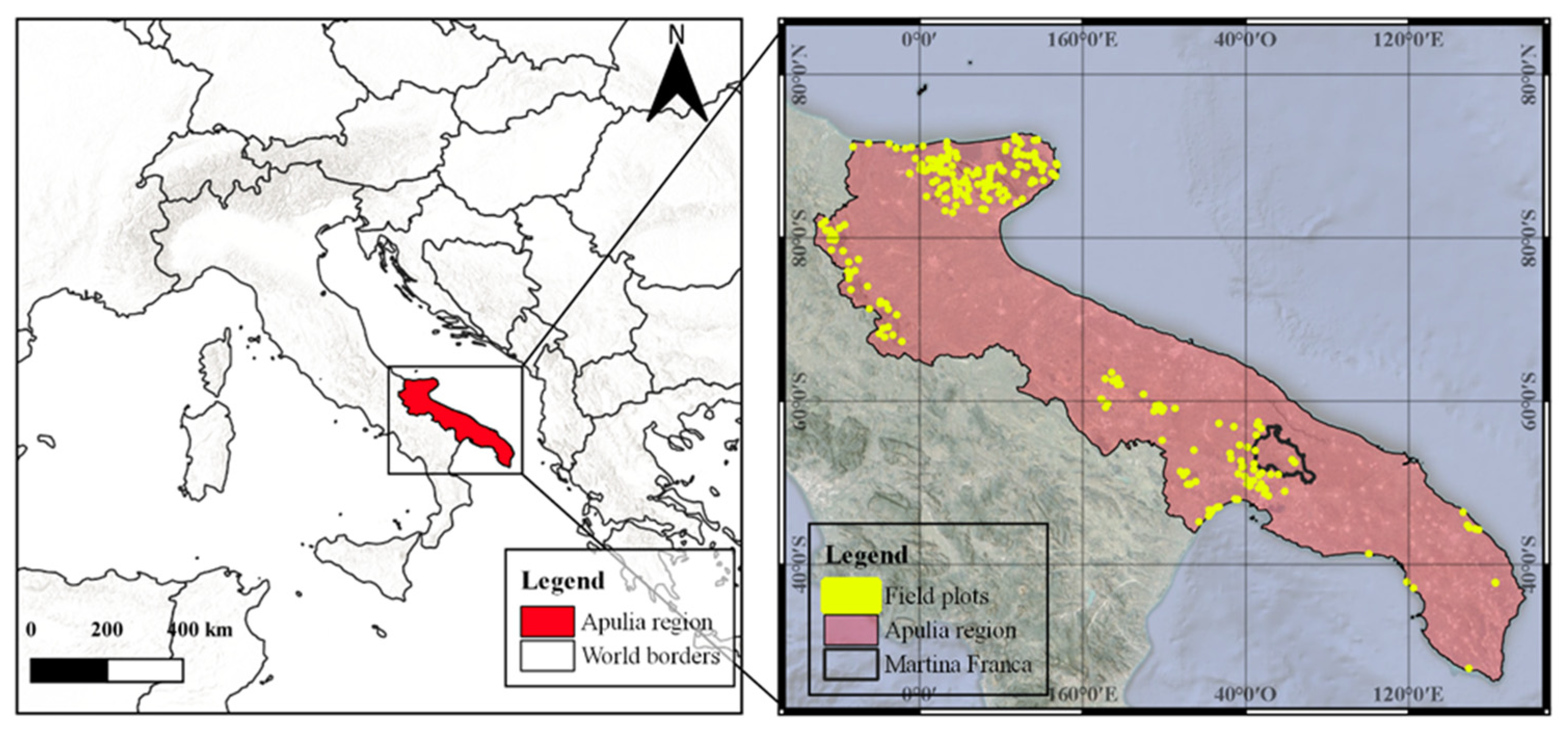
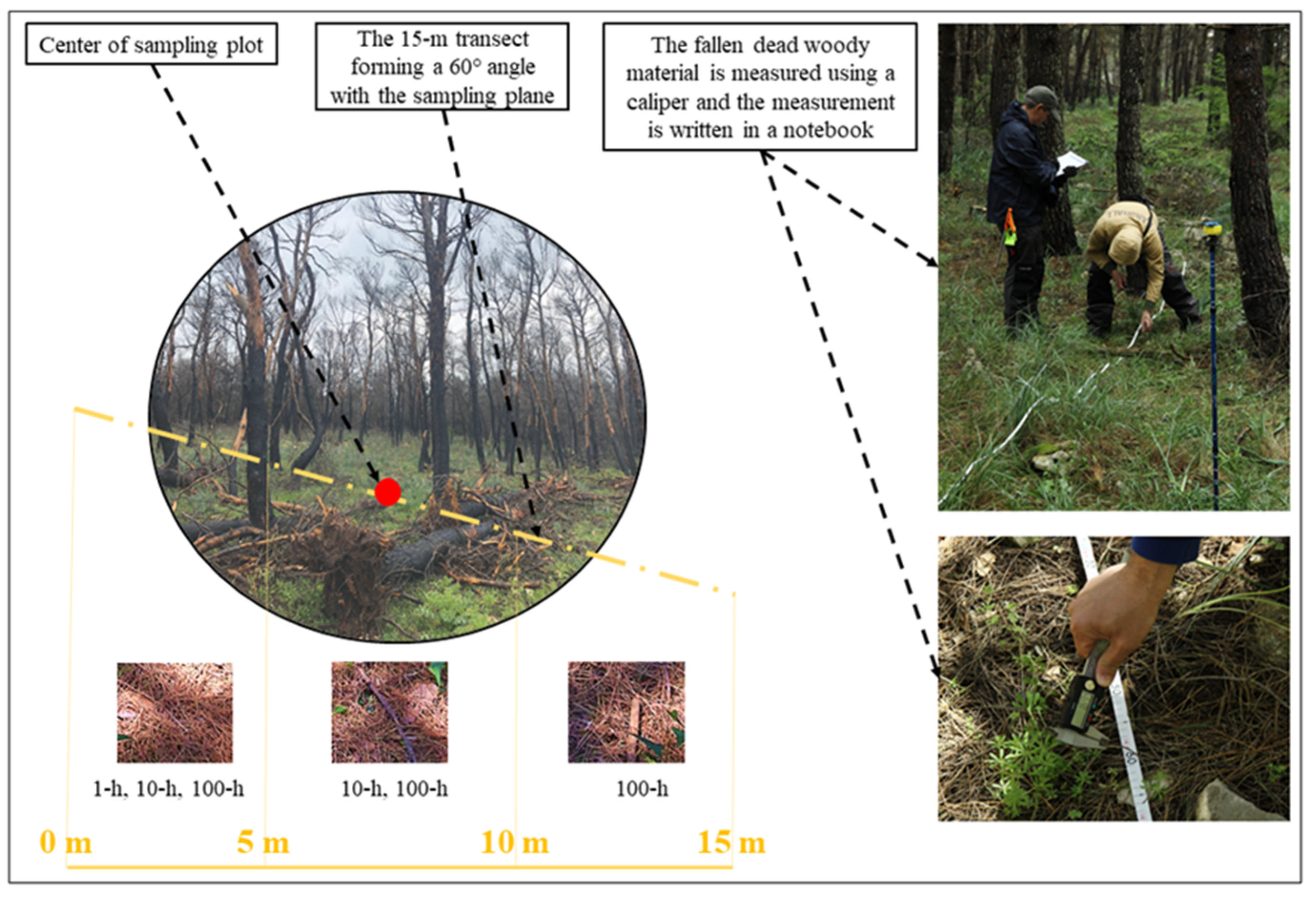
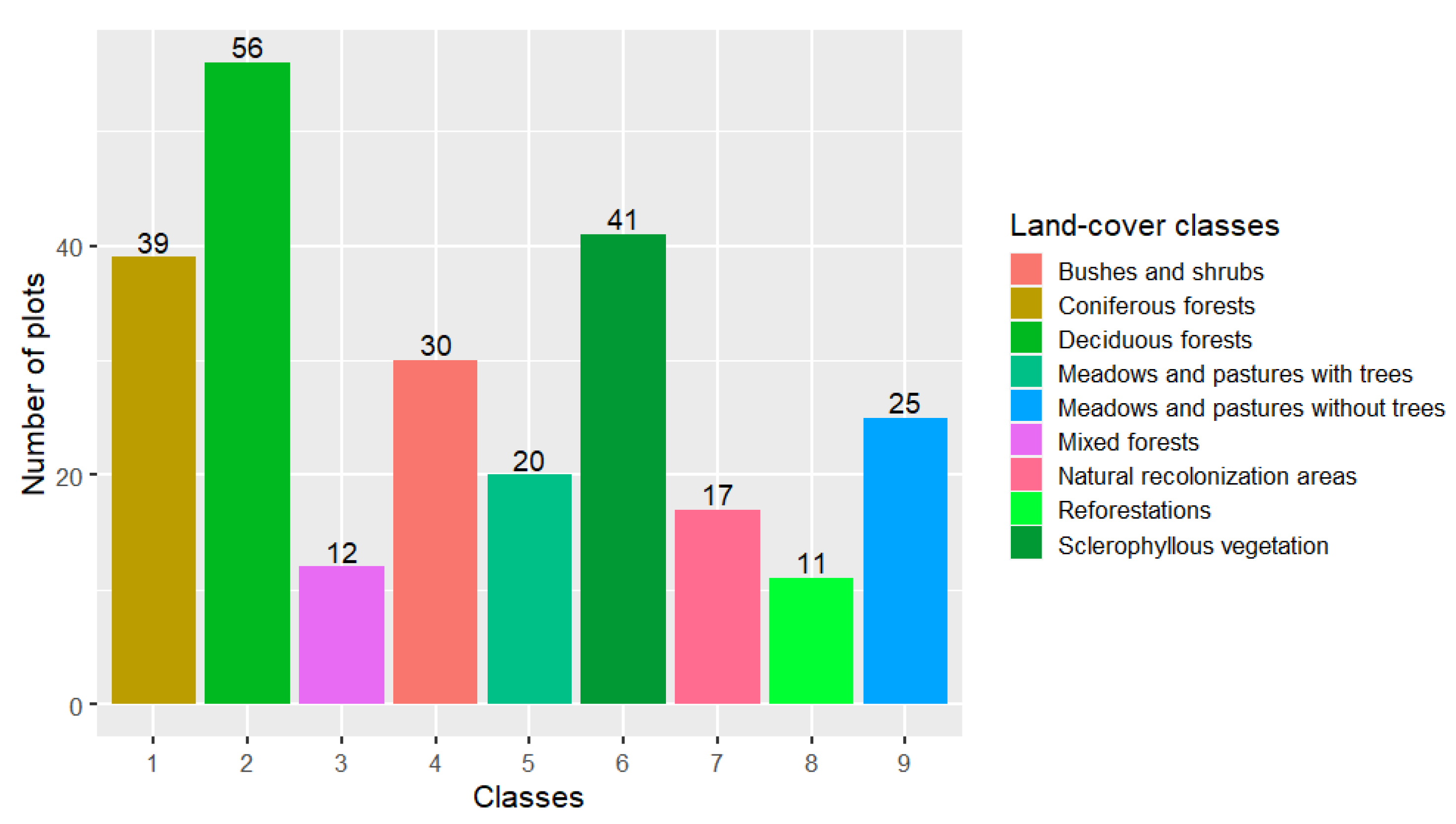
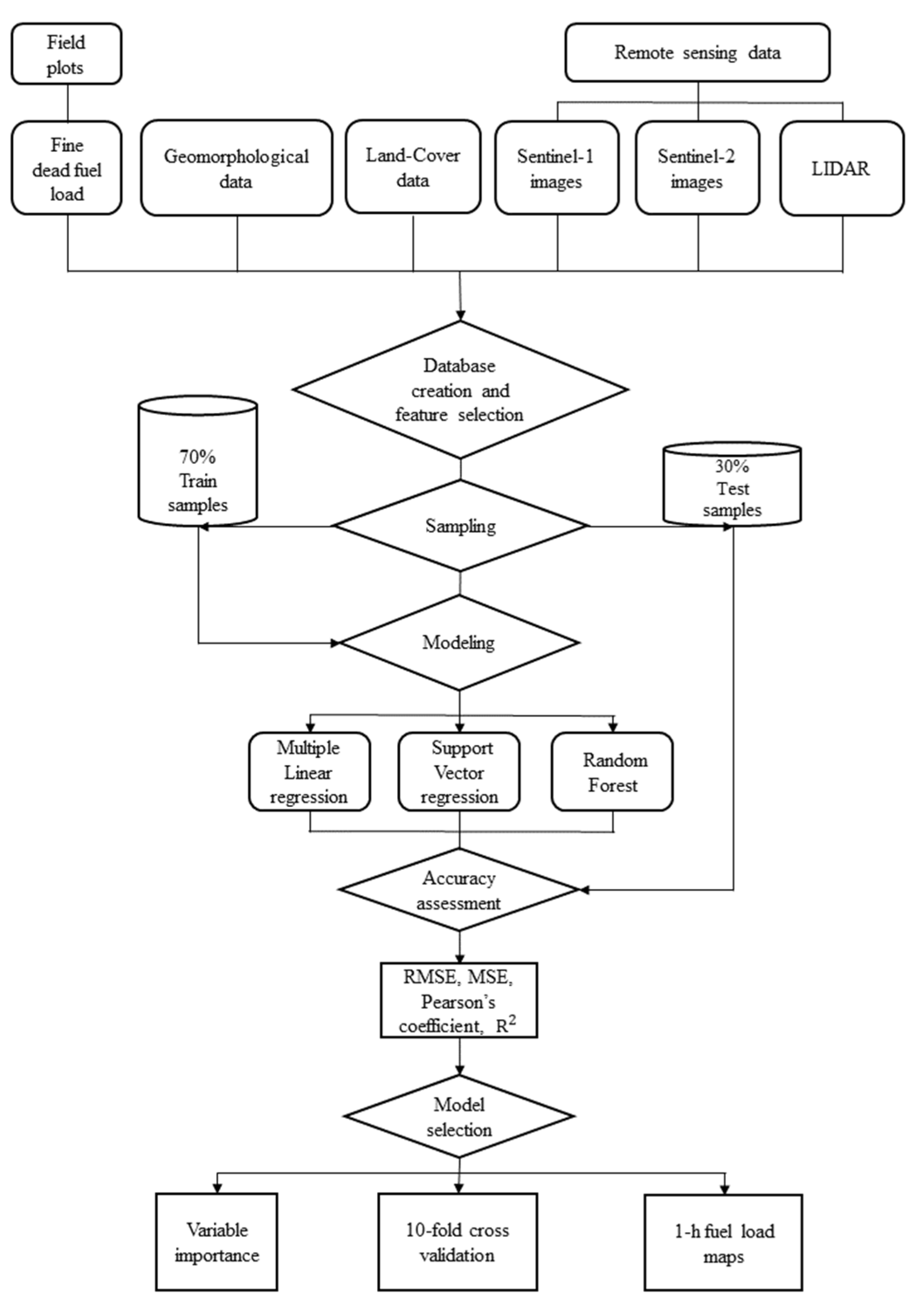
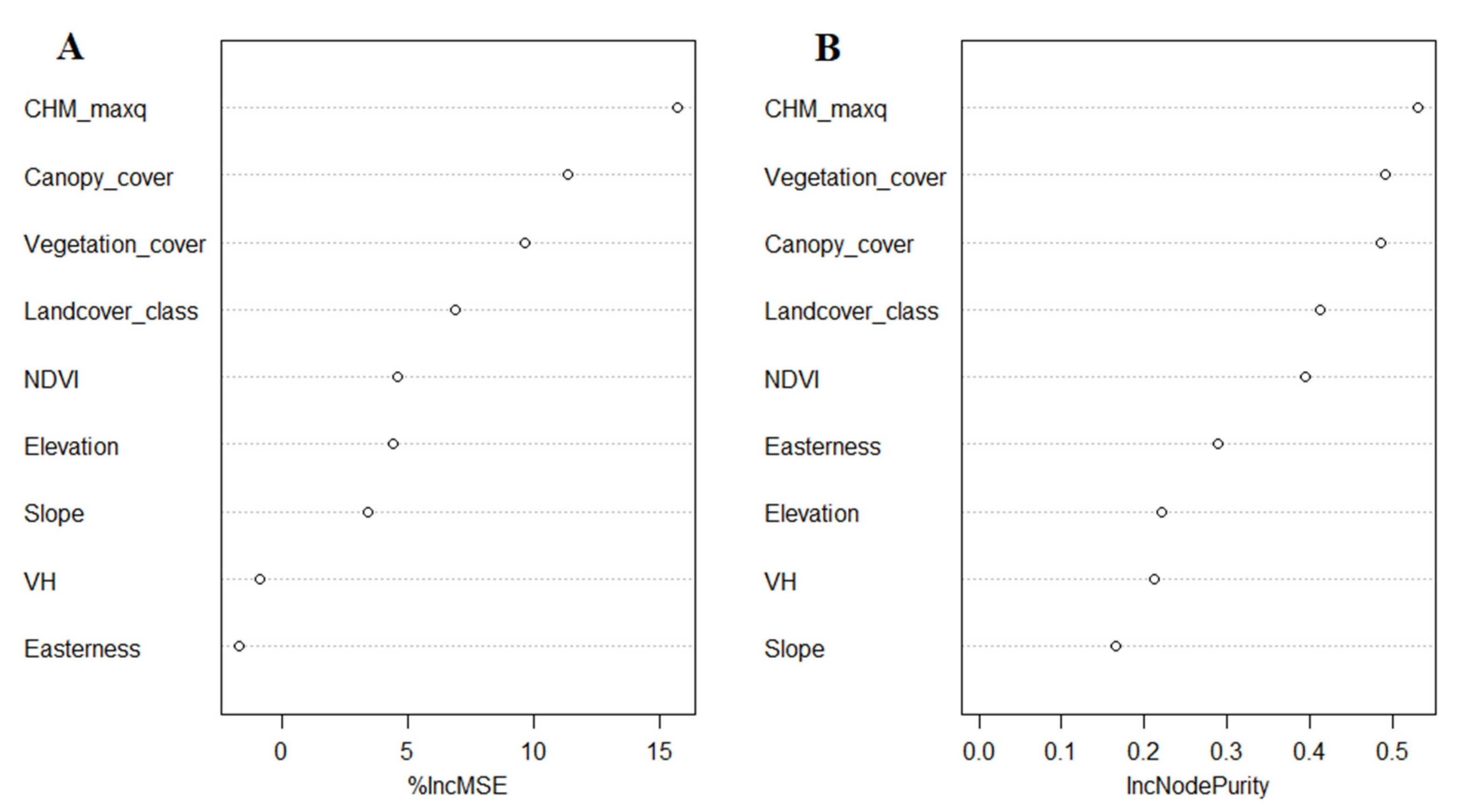

| Sub-Regions | Number of Relative Orbits | Orbit | Number of Images | Polarization Band |
|---|---|---|---|---|
| Gargano Promontory | 146 | Ascending | 25 | VV, VH |
| Daunian Subappenines | 44 | Ascending | 26 | VV, VH |
| Murge | 146 | Ascending | 50 | VV, VH |
| Arco Jonico Tarantino | 146 | Ascending | 38 | VV, VH |
| Salentinian peninsula | 146 | Ascending | 25 | VV, VH |
| Plots (N) | Mean (t/ha) | SD | SE | Range | |
|---|---|---|---|---|---|
| Coniferous Forests | 39 | 0.80 | 0.45 | 0.07 | 0.12–1.92 |
| Deciduous Forests | 52 | 1.13 | 0.66 | 0.09 | 0.05–4.10 |
| Mixed Forests | 10 | 0.92 | 0.66 | 0.21 | 0–2.09 |
| Bushes or Shrubs | 30 | 0.38 | 0.43 | 0.08 | 0–1.97 |
| Sclerophyllous Vegetation | 41 | 0.48 | 0.45 | 0.07 | 0–2.34 |
| Meadows or Pastures (with Trees) | 20 | 0.29 | 0.26 | 0.06 | 0.03–1.10 |
| Meadows or Pastures (without Trees) | 25 | 0.14 | 0.19 | 0.04 | 0–0.86 |
| Natural Recolonization Areas | 16 | 0.43 | 0.42 | 0.10 | 0.01–1.83 |
| Reforestations | 11 | 0.51 | 0.38 | 0.11 | 0.02–1.15 |
| RMSE | MSE | r | R2 | |
|---|---|---|---|---|
| MLR | 0.11 | 0.01 | 0.63 | 0.40 |
| SVM | 0.10 | 0.01 | 0.63 | 0.39 |
| RF | 0.09 | 0.01 | 0.71 | 0.50 |
| RMSE | MSE | r | R2 | |
|---|---|---|---|---|
| Subsample 1 | 0.10 | 0.01 | 0.70 | 0.50 |
| Subsample 2 | 0.13 | 0.02 | 0.66 | 0.44 |
| Subsample 3 | 0.10 | 0.01 | 0.68 | 0.47 |
| Subsample 4 | 0.11 | 0.01 | 0.60 | 0.36 |
| Subsample 5 | 0.10 | 0.01 | 0.68 | 0.46 |
| Subsample 6 | 0.10 | 0.01 | 0.67 | 0.45 |
| Subsample 7 | 0.10 | 0.01 | 0.65 | 0.42 |
| Subsample 8 | 0.11 | 0.01 | 0.63 | 0.39 |
| Subsample 9 | 0.10 | 0.01 | 0.71 | 0.51 |
| Subsample 10 | 0.09 | 0.01 | 0.71 | 0.57 |
| Land-Cover Class | 1-h Fuel Load (t/ha) | Total Area (ha) | ||||
|---|---|---|---|---|---|---|
| 0.01–0.14 | 0.14–0.18 | 0.18–0.21 | 0.21–0.26 | 0.26–0.53 | ||
| Coniferous | 2.60 (3.85%) | 19.26 (28.48%) | 15.68 (23.19%) | 26.99 (39.91%) | 3.09 (4.57%) | 67.62 |
| Deciduous | 470.74 (7.63%) | 1294.65 (20.98%) | 1465.94 (23.76%) | 1433.25 (23.23%) | 1506.44 (24.41%) | 6171.02 |
| Mixed | 0.91 (4.09%) | 4.31 (19.35%) | 4.38 (19.67%) | 6.62 (29.73%) | 6.05 (27.17%) | 22.27 |
| Bush or Shrubs | 104.34 (78.33%) | 16.21 (12.17%) | 4.06 (3.05%) | 7.55 (5.69%) | 1.04 (0.78%) | 133.2 |
| Sclerophyllous Vegetation | 532.45 (66.26%) | 180.15 (22.42%) | 32.70 (4.07%) | 48.64 (6.05%) | 9.61 (1.20%) | 803.55 |
| Meadows or Pastures (with Trees) | 73.92 (89.02%) | 6.09 (7.33%) | 1.28 (1.54%) | 1.62 (1.95%) | 0.12 (0.14%) | 83.03 |
| Meadows or Pastures (without Trees) | 331.76 (97.53%) | 5.06 (1.49%) | 1.90 (0.56%) | 1.42 (0.42%) | 0.02 (0.01%) | 340.16 |
| Natural Recolonization Areas | 9.56 (86.67%) | 0.65 (5.89%) | 0.46 (4.17%) | 0.31 (2.81%) | 0.05 (0.45%) | 11.03 |
Publisher’s Note: MDPI stays neutral with regard to jurisdictional claims in published maps and institutional affiliations. |
© 2021 by the authors. Licensee MDPI, Basel, Switzerland. This article is an open access article distributed under the terms and conditions of the Creative Commons Attribution (CC BY) license (https://creativecommons.org/licenses/by/4.0/).
Share and Cite
D’Este, M.; Elia, M.; Giannico, V.; Spano, G.; Lafortezza, R.; Sanesi, G. Machine Learning Techniques for Fine Dead Fuel Load Estimation Using Multi-Source Remote Sensing Data. Remote Sens. 2021, 13, 1658. https://doi.org/10.3390/rs13091658
D’Este M, Elia M, Giannico V, Spano G, Lafortezza R, Sanesi G. Machine Learning Techniques for Fine Dead Fuel Load Estimation Using Multi-Source Remote Sensing Data. Remote Sensing. 2021; 13(9):1658. https://doi.org/10.3390/rs13091658
Chicago/Turabian StyleD’Este, Marina, Mario Elia, Vincenzo Giannico, Giuseppina Spano, Raffaele Lafortezza, and Giovanni Sanesi. 2021. "Machine Learning Techniques for Fine Dead Fuel Load Estimation Using Multi-Source Remote Sensing Data" Remote Sensing 13, no. 9: 1658. https://doi.org/10.3390/rs13091658
APA StyleD’Este, M., Elia, M., Giannico, V., Spano, G., Lafortezza, R., & Sanesi, G. (2021). Machine Learning Techniques for Fine Dead Fuel Load Estimation Using Multi-Source Remote Sensing Data. Remote Sensing, 13(9), 1658. https://doi.org/10.3390/rs13091658











